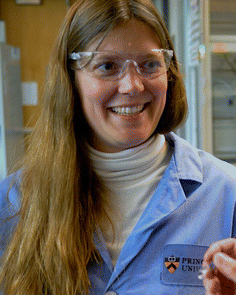Nanoscale Horizons Emerging Investigator Series: Dr Leslie Schoop, Princeton University, USA
Abstract
Our Emerging Investigator Series features exceptional work by early-career nanoscience and nanotechnology researchers. Read Leslie Schoop's Emerging Investigator Series article ‘Chemical exfoliation of 1-dimensional antiferromagnetic nanoribbons from a non-van der Waals material’ (https://doi.org/10.1039/D3NH00408B) and read more about her in the interview below.
Dr Leslie Schoop received her diploma in chemistry from Johannes Gutenberg University and PhD in chemistry from Princeton University. She then went on to work as a Minerva fast-track fellow under Professor Bettina Lotsch at the Max Planck Institute for Solid State Research. Leslie joined the Princeton University Department of Chemistry faculty in 2017 and was tenured in 2022. The Schoop Lab is working at the interface of chemistry and physics, using chemical principles to find new materials with exotic physical properties.
Read Leslie Schoop's Emerging Investigator Series article ‘Chemical exfoliation of 1-dimensional antiferromagnetic nanoribbons from a non-van der Waals material’ ( https://doi.org/10.1039/D3NH00408B ) and read more about her in the interview below:
NH: Your recent Nanoscale Horizons Communication reports the chemical exfoliation of ionically bonded crystals for the synthesis of 1D nanoribbons, demonstrating that compounds other than van der Waals materials can be chemically exfoliated to form 1-dimensional structures. How has your research evolved from your first article to this most recent article and where do you see your research going in future?
LS: We are still interested in the topic of exfoliating non-van der Waals (vdW) materials, both to 1D and 2D nanostructures. We are continuing in both directions and are interested in how we can enhance the quality of exfoliated nanostructures so that they can be used in electronic applications. We are pursuing an idea that, in some cases, starting from a non-vdW material can yield higher quality nanostructures compared to beginning exfoliation from a vdW compound.
NH: How do you feel about Nanoscale Horizons as a place to publish research on this topic?
LS: Nanoscale Horizons is a great journal; the RSC's flagship for nanoscience. I’m looking forward to hopefully publishing a lot more of our work in the journal.
NH: What aspect of your work are you most excited about at the moment?
LS: Oh, there are so many. My group does much more than nanoscience, however, when I limit myself to that area of my group, I think it is the idea that using soft-chemical methods, we can introduce a whole suite of new quantum materials. We have several leads (and publications), but we are constantly improving and learning more. I think the field of quantum matter can really learn a lot from exploring more wet chemistry.
NH: In your opinion, what are the most important questions to be asked/answered in this field of research?
LS: The biggest challenge is making materials of very high crystallinity, reducing the number of defects. If you use soft-chemical methods and operate at room temperature, you often make metastable materials. This will preclude you from using annealing to heal defects. Defects can be detrimental to the performance of many types of quantum materials. Thus, finding ways to avoid them without annealing is key.
NH: What do you find most challenging about your research?
LS: I don’t think that there is any one thing.
NH: In which upcoming conferences or events may our readers meet you?
LS: I regularly attend the APS March Meeting, sometimes ACS. I often like to join smaller, topic-related conferences too.
NH: How do you spend your spare time?
LS: I have a 3-year-old son, so most of my spare time is spent with him. Should I have more time, I enjoy hiking and gardening. In the winter, I love playing board games.
NH: Can you share one piece of career-related advice or wisdom with other early-career scientists?
LS: Don’t be afraid to delegate tasks.
| This journal is © The Royal Society of Chemistry 2024 |

